Welcome to the fourth instalment in our safety feature campaign series: Devitt Rider Safety with road safety journalist @djrwilliams.
We’re on a mission to create heightened awareness and debate around vital rider safety topics, initiatives and campaigns. Riders love to talk about all the latest safety and riding skills and here, at Devitt, we aim to be at the very forefront of that discussion.
Join the debate today on social media at #DevittRiderSafety
Biking’s seldom more enjoyable than when you have a set of knobbly tyres – and miles of muddy green lanes to explore.
Riding off-road isn’t just enormous fun though; it’s a great way to hone your skills, making you more confident, sure-footed and safer on the road.
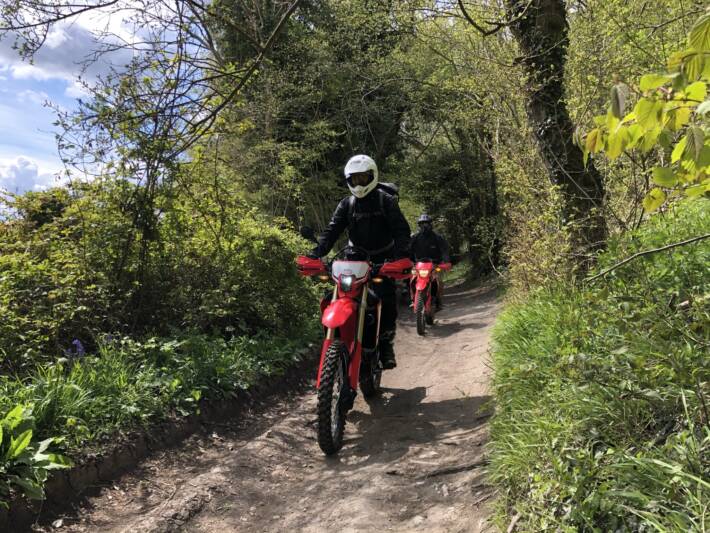
It tunes your balance, makes you intimately aware of your – and your bike’s – limits and prepares you for the unexpected; that split-second loss of grip which, if you’re not used to it, can end in disaster.
Which sums up why one of Britain’s leading motorcycle training schools, Phoenix Motorcycle Training, which for years has specialised in putting learners through their CBT and coaching advanced riders, has launched its very own trail tiding centre, a short ride from London.
It’s bought a small fleet of bright red new Honda CRF 250Ls fitted with all-purpose tyres, hand guards and other essential mods so that they’re fit for the miles of green lane minutes from the organisation’s training ground at Sidcup, Kent.
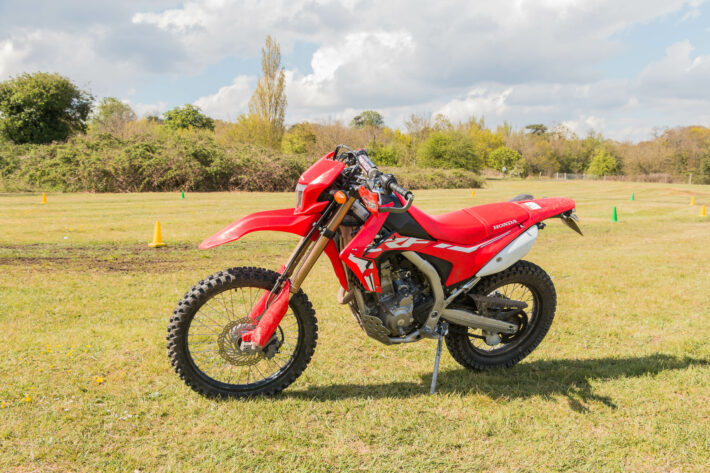
Next step was to buy a shed-load of helmets, gloves, boots and protective wear – and appoint a team of enthusiastic, experienced trainers.
Loose surfaces
The concept is simple and Phoenix offers offer four different stages of off road motorbike training. The first is a two-hour £60 ‘taster’ session, open to any budding rider with or without a bike licence provided they have basic riding skills.
After a safety introduction, participants are encouraged to get used to riding over loose surfaces including grass, mud and gravel. Much of the riding is around cones and there are frequent stops for tips and advice from instructors.
Novices are told how to get on and off the bike, how to sit – or stand – and how to balance so that they keep enough weight over the front wheel for grip in bends, while maintaining balance. Once confidence grows, there’s a short green lane-style trail through an adjacent patch of woodland, where riders follow an instructor.
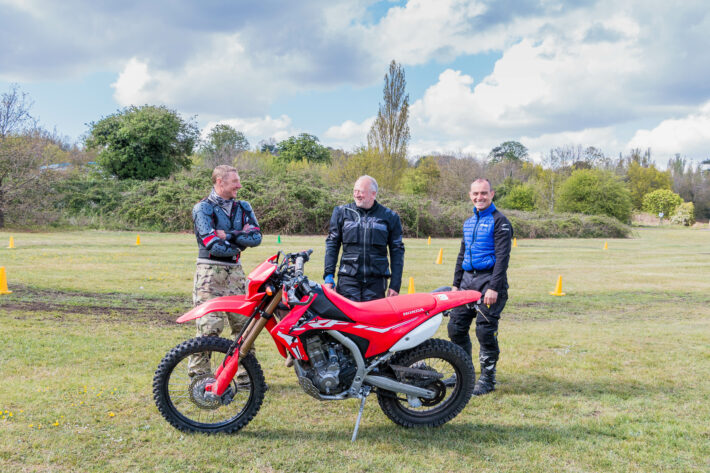
Riders can also brave a small hill to gauge their balancing skills before negotiating muddy ruts, logs partly buried in the ground and a deep, water-filled trench that looks easy but that’s tricky enough to show up the skills even of a pro…
Those who love the experience – most do – can carry on through three different levels. They range from ‘easy’ to ‘very challenging’, starting with Level 1 which gives riders six hours in the saddle, starting on the training ground before riding out onto the road to discover miles of undulating green lane for £240 at the weekend.
Levels three to four involve full-day rides around southern England, with bikes delivered to strategic points including Kent and Salisbury, in a van, for prices ranging from £240 – £500.
I strapped on as much protective gear as I could find and joined the team for Level 1.
Unnerving
There’s no way of getting around it; it’s unnerving when – after years of road riding – a bike on knobblies develops a mind of its own on mud or grass; it just feels wrong when the back – or front – wheel slithers sideways. But after weaving in and out of cones for 30 minutes I stopped tensing up and it began to feel more natural as, feeding in the power, I’d feel the rear – or front – wheels slide. Usually in the right direction…
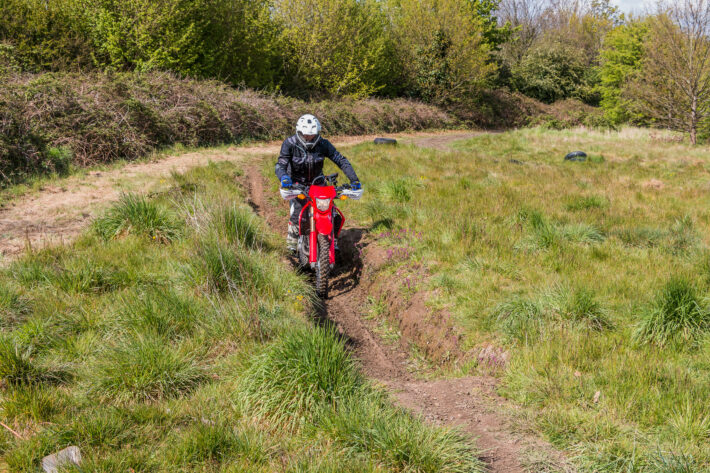
After breaking the ice with a minor tumble that saw me land on my feet and the bike fall harmlessly on its side, I was ready for the woodland trail. With tips from instructors Adam Augustin and Roger Pitt – both highly experienced off-roaders – I was soon loving every second and trying to copy Roger’s trial-style body position as he leaned off the bike, to counterbalance in bends.
The hill was child’s play and – by allowing the bike to ‘find’ its own way over the ruts by resisting the temptation to grip the handlebars – even that section was fun. The secret, it seems, is knowing that the bike will usually take you where you’re looking – if you hang on long enough and fight the tension.
The deep trench proved harder, reinforcing Adam’s advice ‘Look where you want to go – because you’ll always end up going where you look’. I found it impossible not to focus on the muddy ‘walls’ with the result that I found myself pinned to them by the bike more than once.
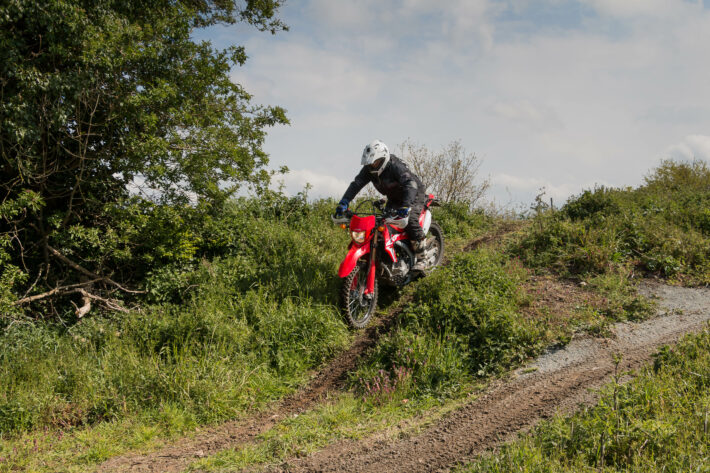
The final lesson – before a cuppa and hitting the road – was the log path, which demanded momentum, balance, careful clutch control and – again – looking where I wanted to go, not where I feared I’d land if it all went wrong.
Fully legal
We clocked up 80 kilometres on a scintillating ride incorporating minor roads and lots of fully-legal green lanes through woodland, alongside fields, over picturesque hills, along rutted muddy tracks, gravel and grass.
Stopping for riding tips in advance of tricky sections – water-filled ruts, steeply ascending log paths, deep gravel, wet tree roots, narrow sections in between slippery grass – my balance, confidence and riding skills improved fast.
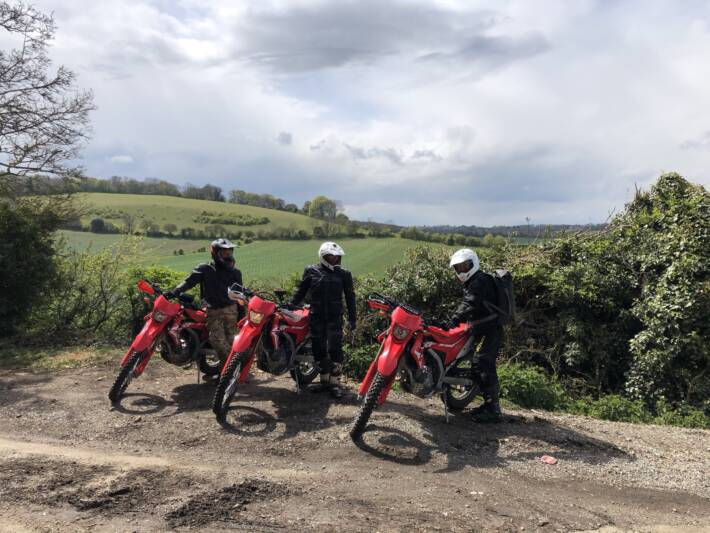
The best section came at the end when – thanks to a permit bought by Phoenix – we entered a hilly private stretch of green lane winding through forestry land, dotted with deep, rutted puddles – and picked up speed. The sense of achievement, excitement and fun as we swooped along the brow of a hill was addictive. At times it felt like flying.
The CRF250Ls were ideal for the job; light enough to manhandle through tough sections, easy to pick up if dropped, and easy to control. But watch those knobblies, which can make you run wide on tarmac in bends.
Not just fun
“It’s not just fun – it really does improve all-round riding skills,” maintains Adam, the off-road team leader. “Knowing how your bike behaves when it’s on a loose surface, when it’s off-balance, when it’s sliding – and doing that somewhere safe and in the right conditions – hugely benefits anyone’s riding.
“It’s partly about learning not to tense up when the bike moves around. If you can learn to ride relaxed, to go with the flow, not to go stiff in the arms, not to grip the handlebars, not to fight the bike, you will emerge a far better, safer rider. As soon as you tense up, that is when you prevent the bike from doing what it wants to do. What it wants to do is remain balanced, and get over the next obstacle!”.
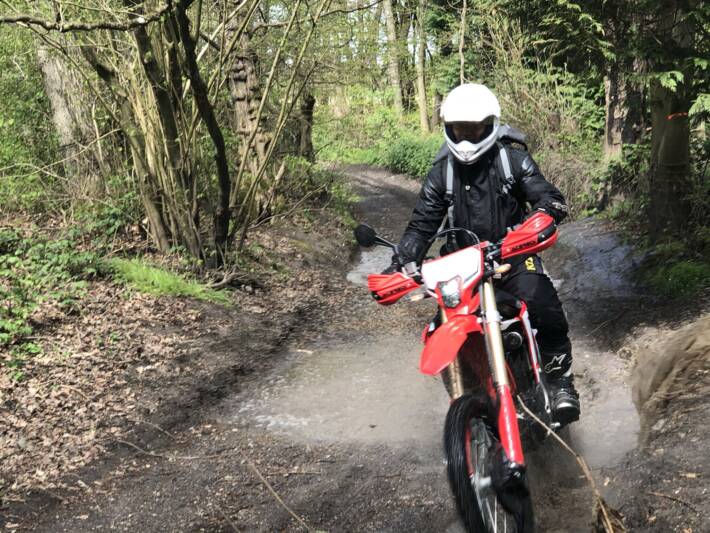
Adds instructor Roger Pitt: “Off-road riding also reaches you to sort out your braking and speed before you get to a bend, or hazard. You can’t get away with getting it wrong when you’re on mud, or gravel.”
Above all, it’s fun – but also hard work. During the afternoon my energy levels plummeted and – knowing I’d start making mistakes – we headed back to base for another cuppa and further discussions on technique. The following day, muscles I’d long forgotten about reminded me, painfully, of a fun day in the saddle; riding off-road might be educational but it’s far more physically demanding than riding on Tarmac. And that’s just Level 1…
Next time I need to ride over grass, gravel or mud – whether it’s in a carpark or maybe at a road junction or roundabout – I’ll be better prepared.
DO OFF-ROAD RIDING SKILLS REALLY HELP YOU ON-ROAD?
Few can answer this better than PC Chris Tall of Northamptonshire Police, who is the Force Motorcycle Co-ordinator, responsible for all motorcycle activity on and off-road. He also works for the force’s driver training unit for cars as well as on and off-road bikes, and is involved in National BikeSafe, the police-led motorcycle safety initiative.
Unlike some forces, Northamptonshire has an off-road motorcycle ‘squad’, currently equipped with Yamaha WR 250s, but soon moving up to new Yamaha WR 450s. Around 18 officers – including PCSOs – use the off-roaders for a variety of roles including rural policing and accessing areas other vehicles can’t easily get to. They are also used to respond to calls from members of the public who complain about motorcyclists riding illegally off-road, a frequent problem in Northamptonshire. The off-roaders are also a good ‘ice-breaker’ for officers to mix with motorcyclists and the general public at events, says Chris.
Kerbs and ruts
All Northamptonshire police off-road riders undergo a week-long specialist course, so that they become familiar with manoeuvring off-road bikes over obstacles such as kerbs and ruts.
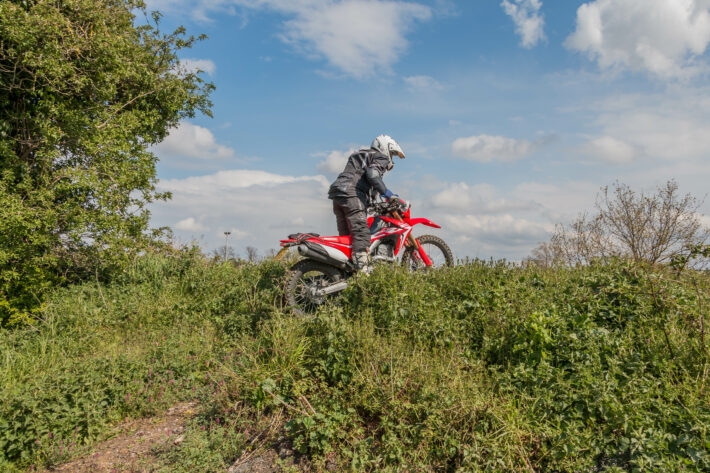
“It’s quite a basic course but we start off in a car park for basic manoeuvres at low speed,” says Chris. “They learn how to physically handle the bike, pushing it around, laying it down and picking it up – riding off-road does come with a bit of falling off after all! We accept that when it’s wet and muddy, or our feet slip when we’re getting off and we might fall over so need to know how to deal with that.
“We do not do extreme off-roading; we just need to be able to ride along footpaths and alleyways and bridleways, and be able to go into areas where there are issues and make sure we’re not going to embarrass ourselves riding towards people over heathland, mud or grass. It’s about being able to navigate all types of terrain.”
According to Chris, few skills are directly transferable from off-road to on-road, as they are two different disciplines, but he adds: “When you’re riding off-road you do get to appreciate that if the bike is a bit skittish underneath you or the back wheel steps out or you lock the front wheel up, it does not mean you’re going to fall off.
Wet leaves
“It allows you to recognise that the bike can be quite forgiving as long as you relax into it and you are riding correctly. You can afford for it to slide around under you. While we would never say you should ride your on-road bike in a fashion where you’re allowing it to slide, I think that if you do hit that wet patch you’re not expecting, wet leaves or diesel and the bike steps out a little from underneath you, you don’t need to panic; the bike is probably going to be OK.
While it feels like the back wheel has slid two or three feet, it’s probably only a few inches; it feels worse that it is and you get used to that off-road.”
Chris, who says that the number of police forces that have off-road riding capability is rising, says that off and on-road bikes are very different machines with different tyres, suspension and handling characteristics.
But he adds: “Off-road riding is about developing that confidence that gives you a different feel for the bike, it makes you realise you can move yourself around on the bike to help your balance.
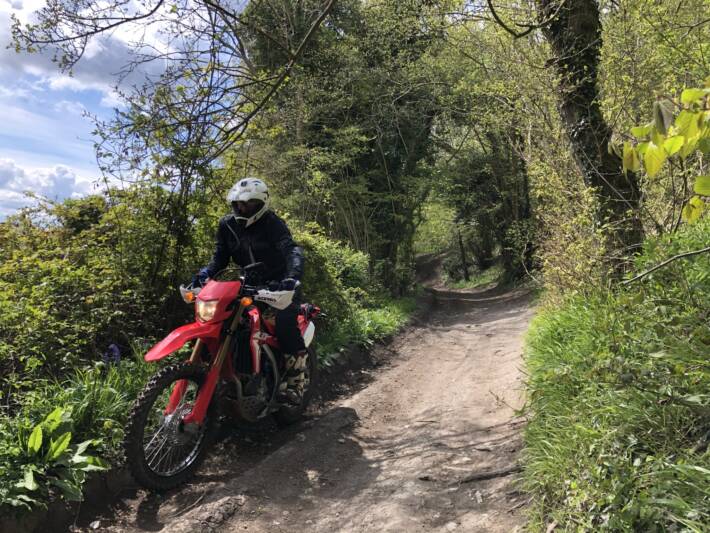
“For me, riding off-road certainly helps the way I balance, including pushing down on the foot pegs; that kind of thing. Those skills can come in handy if you find yourself in a situation where you need to negotiate something at slow speed.”
Adds Chris, who owns a Ducati Multistrada: “If you relax into it, when something unforeseen does happen, you tend to deal with it better having had the benefit of riding off-road. You can’t ride off-road without sliding about over wet tree roots and that kind of thing; you bend your knees, your body is more relaxed and you enjoy it when it happens; it’s part of off-road riding and it all helps.”
Want to know where to ride?
The Trail Riders Fellowship website has a wealth of information about how to get started – and how to find legally-approved green lanes, so that you can ride on the right side of the law. More at https://www.trf.org.uk/
More information on Phoenix Motorcycle Training https://phoenixmotorcycletraining.co.uk/trail-riding/
David Williams is a freelance journalist who specialises in road safety, transport and travel. He’s been the London Evening Standard’s motoring correspondent for 26 years, also contributing to the Daily and Sunday Telegraph, Sunday Times and various magazines. He is a Prince Michael of Kent International Road Safety Awards judge.
Twitter Handle – @djrwilliams
One comment on “Does off road motorbike training make you a better rider?”
Off road training definitly makes a better rider, I am of an age to remember the Dave Taylor facility. Personally though I think there should be a proper off road centres with a proper course structure BEFORE CBT. Guess back when I was 16 and graduated from field bikes to riding on the road, most already had command of the basics, and indeed maintainance and understanding of how things on the bike worked.